Before the Civil War, Richmond was, in the words of historian Rollin Osterweis, the “intellectual headquarters” of the upper South. In days of yore, it was also, not by chance, the regional capital of trendy medievalism.
In a state formed by the manners and patterns of English life, the Richmond-based Southern Literary Messenger (edited by Edgar Allan Poe) reinforced the romanticism of its readers by treating them to Gothic yarns, the pageantry of Sir Walter Scott, the thought of Thomas Carlyle, and, in the twenty years before the Civil War, mountains of chivalric poems. The wealthy in and around antebellum Richmond adored chivalric pageants and tournaments; by the 1850s, writes Osterweis, “[i]nstead of longing awkwardly for the days of knighthood, the gentry is now convinced that it is living in them.”
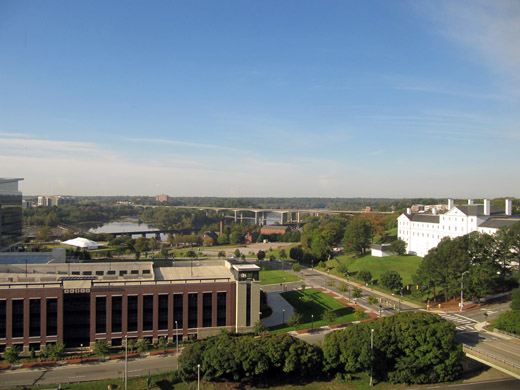
This weekend, I was honored to be a guest at the annual James River Writers Conference, an event hosted by what may be the most hospitable writers’ group in the country. New to a city that was once obsessed with knighthood, courtliness, and English heritage, I took advantage of glorious weather to track down charming traces of old, neo-medieval Richmond.
Crammed between newer buildings on 5th Street is the Second Presbyterian Church, completed in 1848. Here, we’re told, the first pastor “proclaimed that he was ‘tired of Grecian temples with spires on them'” and “determined to build the first Gothic church in Richmond, a city noted for its classic Greek architecture. His building committee persuaded the noted New York Architect Minard Lafever, one of the leading masters of the Gothic Revival in America, to design the building.”
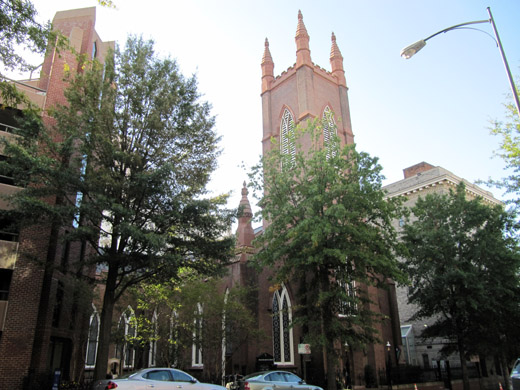
Ages later, the parking deck next door feebly acknowledges its Gothic elder.
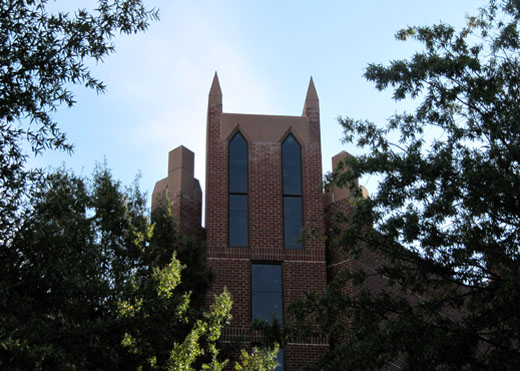
Old buildings in Richmond favor classical and Federal styles intermingled with eclectic Victoriana, but on the eastern edge of Monument Avenue, Jeb Stuart, statuesque, presides over a Gothic revival.
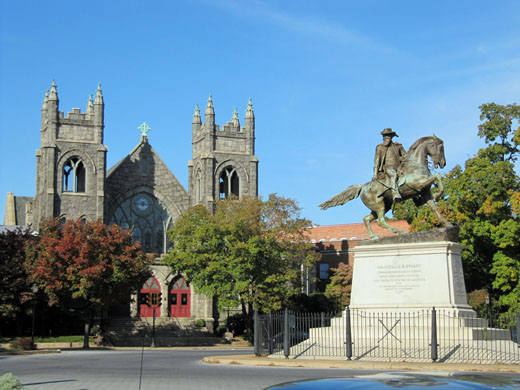
It’s the right assignment for a general whose biographer calls him “the Confederacy’s knight-errant . . . Amid a slaughterhouse, he had embodied chivalry, clinging to the pageantry of a long-gone warrior. He crafted the image carefully, and the image befitted him. He saw himself as the Southern people envisaged him. They needed a knight; he needed to be that knight.”
Around the statue of Stuart rise the First English Lutheran Church (above), St. John’s UCC (below), and Grace Covenant Presbyterian (photo).
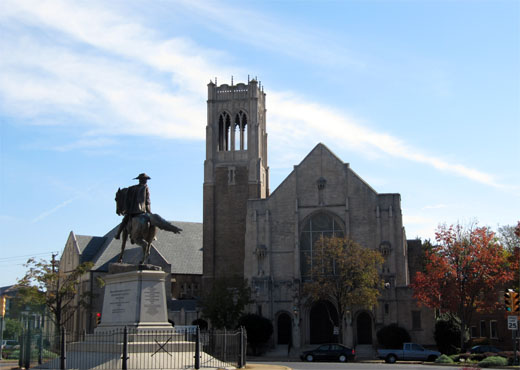
Here, the Gothic fought the Federal to a standstill, if only in facades.
On the north end of town, at Union Presbyterian Seminary, whimsy is the prime mover at Watts Hall, designed by Charles H. Read and built in 1897. Gleefully asymmetrical, Watts is one of those buildings that gets weirder the longer you look at it.
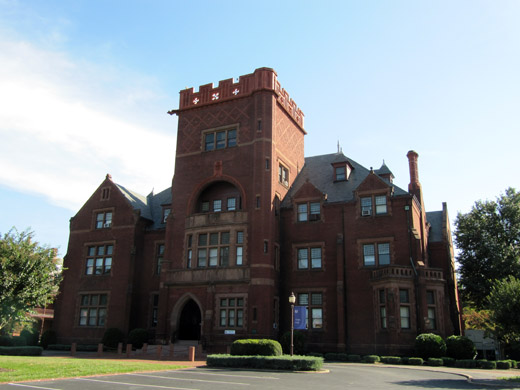
With its buttresses and blind triforium (those little rows of fake indented windows), its chapel could, at first glance, almost pass for medieval, but for that clock tower…
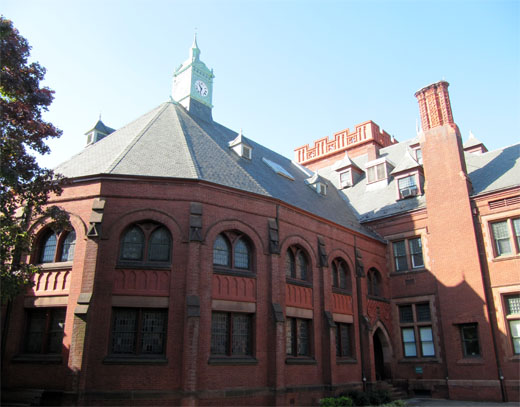
…and the quatrefoil-mad chimneys with wild Corinthian capitals.
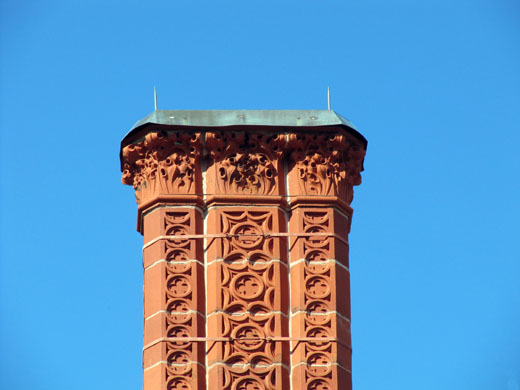
Still, one terrific detail on the front of Watts Hall is all-American Gothic, perhaps befitting an age in which religious architecture is no longer a prominent carrier for medievalist ideas:
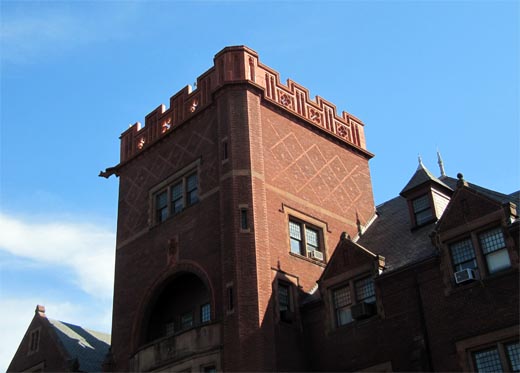
A lone grotesque, fleeing the scourge of theology.
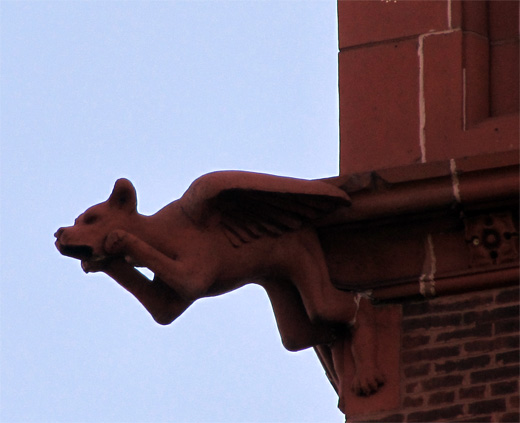

was also, not by chance, the regional capital of trendy medievalism.
Do you see much, if any, trendy medievalism now, beyond some of the examples you’ve depicted?
LikeLike
I haven’t spent enough time in Richmond to have a strong sense of its current culture, but several of the authors at the writing conference were hard at work on some cool medieval-themed historical fiction and fantasy novels. If religious architecture and personal codes of chivalry were two big modes of medievalism for the city in the 19th century, then these writers are certainly rolling with the times and immersing themselves in medievalism as it manifests itself today, largely through popular culture. (I definitely didn’t mean “trendy” to sound pejorative!)
LikeLike